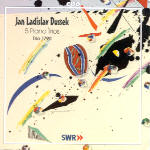Though born in Bohemia, Jan Ladislav Dussek became quite an international musician, living in Paris, then London. He was forced to leave the latter city, narrowly escaping imprisonment when a publishing company he had formed with his father-in-law went bankrupt. Dussek borrowed money from Lorenzo da Ponte (yes, Mozart’s famous librettist) and never repaid it, causing more financial ruin for everyone concerned. But while he was solvent, he was a favorite in London’s music circles as a performer and composer. The Piano Trios are not profound works, having been written to please the greatest number of people, and to sell. The incorporation of Scottish melodies in the Op. 31 trios is charming, but the real reason for their inclusion was that compositions that included these tunes always sold better.
Trio 1790 plays this music with mixed results. Though Dussek was a composer who fought for a greater range on keyboard instruments and was very interested in new pianoforte technology, this ensemble has chosen to use original instruments. The pianoforte Harold Hoeren plays in the Op. 31 trios has a decent sound, reasonably even and only slightly percussive, but a different one is used for the F and B-flat major trios and it’s downright clunky and distracting. All of the performers play with accomplished technique and a breezy sense of style, but the piano sound takes some getting used to. No wonder Dussek wanted improvements! The recording is a little close, a range that normally would be fine, as it is in the Op. 31 works, but overall seems a bit too crowded.
































